
Perrine's Bridge is the second oldest covered bridge in the State of New York, after the Hyde Hall Bridge in East Springfield. Once located in the hamlet called Perrines Bridge between 1850 and 1861. It is located in the modern day town of Esopus-Rosendale, New York just a few hundred feet to the east of Interstate 87 crossing of the Wallkill River in Ulster County, New York. Originally built to aid in the movement of trade between the towns of Rifton and Rosendale, the bridge is about 90 miles north of New York city between mile markers 81 and 82 on the New York State Thruway. In May 1834 the State of New York authorized and provided money ($700) to Ulster county, NY, to build the bridge. In 1835, the bridge was built by Benjamin Wood, the one-lane wooden covered bridge has been closed to vehicular traffic since 1930. The Bridge derives its name from James W. Perrine, a descendant of Daniel Perrin "The Huguenot", who was a tavern keeper that opened an inn on the east side of that future bridge in 1820. Perrine's son was hired each winter as the "snower". He would spread snow the length of the structure so horse-drawn sleighs could cross.

This is a list of more than 1,100 properties and districts in Nebraska that are on the National Register of Historic Places. Of these, 20 are National Historic Landmarks. There are listings in 90 of the state's 93 counties.
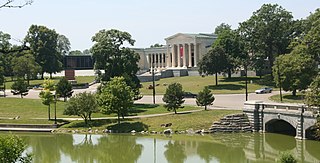
Delaware Park–Front Park System is a historic park system and national historic district located in the northern and western sections of Buffalo in Erie County, New York. The park system was designed by Frederick Law Olmsted and Calvert Vaux and developed between 1868 and 1876.

The Loerzel Beer Hall, also known as "The Brewery" was built in 1873 at 213 Partition Street in Saugerties, Ulster County, New York. It was built about 1873, and is a large three-story, brick building. It measures 45 feet wide and 65 feet deep, and features broad brick gables with lancet openings, a heavy cornice, and decorative cast-iron lintels. It was rehabilitated in 1985. It currently serves as an apartment building.
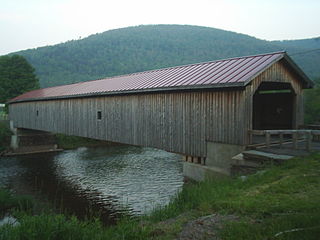
Hamden Bridge is a wooden covered bridge over the West Branch of the Delaware River in the hamlet of Hamden in Delaware County, New York. It was built in 1859, and is a single span, timber and plan framed bridge. It measures 128 feet long and 18 feet wide. A supporting center pier was added in 1940.
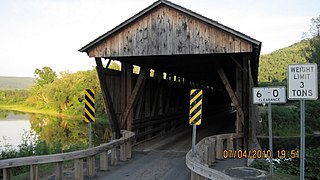
Downsville Bridge is a wooden covered bridge over the East Branch of the Delaware River in the hamlet of Downsville in Delaware County, New York. Designed by Scottish immigrant Robert Murray, the bridge was built in 1854, and is a single span, timber and plan framed bridge. The bridge measures 174 feet (53 m) long and 19 feet (5.8 m) wide.

Salisbury Center Bridge is the only covered bridge in Herkimer County, New York State. It was built in 1875, and is a wood frame Burr Truss bridge measuring 42 feet long and 16 feet wide. The bridge has vertical board siding and is topped by a gable roof. The wooden bridge is one of 29 covered bridges in New York State.

Fitch's Bridge is a wooden covered bridge over the West Branch of the Delaware River. It is in the town of Delhi and is one of 24 covered bridges in New York State. It was originally erected in 1870 in the village of Delhi, and moved to its present location in 1885. The single-span, timber bridge measures 106 feet long and 20 feet wide.

Ashokan Bridge is a wooden covered bridge over Esopus Creek on the grounds of the Ashokan Center, in Ulster County. It was built in 1885, and is a single span, gable roofed, covered timber bridge. It measures 72 feet, 6 inches, long and 16 feet, 4 inches, wide. It was originally located at Turnwood and moved to its present location in 1939. It is situated in the Ashokan Center, which was formerly the Ashokan Field Campus of the State University of New York at New Paltz.

Williamsbridge Reservoir was a natural lake measuring 13.1 acres (5.3 ha) just south of Van Cortlandt Park in the Bronx, New York. Specifically the body of water was located at 208th Street and Bainbridge Avenue. It was shaped like a saucer and was normally 41 feet (12 m) deep. Its water level dropped approximately 14 feet (4.3 m) in mid-August 1901. On April 3, 1934 Commissioner of Water Supply, Gas and Electricity, Maurice P. Davidson, proposed that it be offered to Robert Moses to be used as a park site. The reservoir had ceased to be used after 1919.

Watson Settlement Bridge is a historic covered bridge in eastern Littleton, Maine, United States. Built in 1911, it is one of the youngest of Maine's few surviving covered bridges. It formerly carried Framingham Road over the Meduxnekeag River, but is now closed to traffic, the road passing over a modern bridge to its south. It was listed on the National Register of Historic Places in 1970.
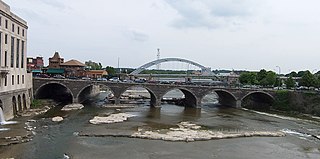
Court Street Bridge is a historic stone arch bridge located at Rochester in Monroe County, New York. It was designed by city engineer J. Y. McClintock, constructed in 1893, and spans the Genesee River. It has six shallow arches over the river and two arches over the Johnson and Seymour Raceway and Erie Canal. Shallow arch spans are 52 feet and rises vary from 13 to 20 feet.

The Mill Street Stone Arch Bridge is located on that street in Pine Hill, New York, United States. It is a small bridge over a local creek built around the turn of the 20th century. It is one of two stone arch bridges in the former village built by local stonemason Matthew G. Thompson. It has remained intact and in use since then, and was listed on the National Register of Historic Places in 1996. It is located in the Pine Hill Historic District.

The Le Grand Bridge was a bridge north of Le Grand, Iowa, United States. It spanned the Iowa River for 242 feet (74 m), carrying traffic on a gravel road named Abbot Avenue. Since Abbott Avenue is the border between Marshall and Tama counties, the bridge is in two counties lengthwise. Many bridges span from one county to another, but few are lengthwise split. It necessitated a joint session of the two counties' Boards of Supervisors on June 29, 1896, to approve the project. The pinned Pratt through truss bridge was built in 1896 by the Marshalltown Bridge and Iron Works for $3,548. It was listed on the National Register of Historic Places in 1998. The bridge collapsed in the Iowa flood of 2008.

House at 176 Prospect Avenue is a historic home located at Sea Cliff in Nassau County, New York. It was built in 1886 and is a 2 1⁄2-story, clapboard residence with a cross-gable, slate-covered roof in the Queen Anne style. It features a 3-story square tower with a hipped roof and board and batten cornice.

House at 195 Prospect Avenue is a historic home located at Sea Cliff in Nassau County, New York. It was built about 1890 and is a two-story house with decorative slate jerkinhead roof in the Late Victorian style. It features a three-bay shed-roof dormer that forms the second floor and covers the entrance porch. It is identical to the House at 199 Prospect Avenue.

House at 58 Eighteenth Avenue is a historic home located at Sea Cliff in Nassau County, New York. It was built in 1893 and is a two-story, three bay clapboard sided residence with a cross gable roof in the Late Victorian style. It features a first floor porch with spindle balustrade and fishscale shingling. Also on the property is a contributing cast iron fence.

This is a list of the National Register of Historic Places listings in Seattle, Washington.
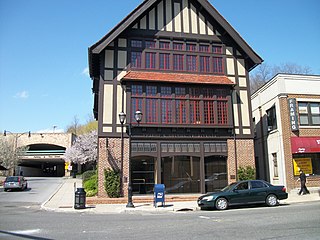
Old Glen Cove Post Office is a historic post office building located at Glen Cove in Nassau County, New York. It was designed by Stephen Voorhees, then with the architecture firm Eidlitz & McKenzie, and built in 1905. It is a three-story Tudor Revival influenced building. It measures 36 feet wide and 70 feet deep, with a rear addition constructed in 1915. The first floor facade is brick, while the two upper stories have applied timbers with stucco infill and French casement windows. The original Glen Cove Post Office building was replaced with the existing building on 2 Glen Cove Avenue in 1932. The old post office is now the headquarters of the Smiros & Smiros architectural firm.

The Stewart Avenue Bridge is a historic structure located in Mason City, in the north-central part of the U.S. state of Iowa. The span carries North Carolina Avenue over the Winnebago River for 116 feet (35 m). This span replaced bowstring arch-truss bridge at this residential location. The Iowa State Highway Commission had the plans completed by November 1913, although the city did not petition the county to have it built until February 1914. N.M. Stark and Company of Des Moines had the low bid at $12,775, which included the removal of the old bridge. Charles Smith provided the fill for the bridge, which opened in August 1914. It was listed on the National Register of Historic Places in 1998.























